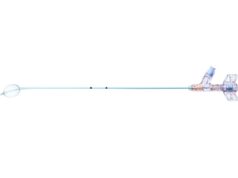
A recent taskforce report charged by the American Society for Bone and Mineral Research (ASBMR) concluded that current evidence does not support the routine use of vertebroplasty for the treatment of pain from vertebral fractures. However, as someone who strongly believes the evidence supports the use of this procedure to alleviate pain, Douglas Beall has significant concerns about the impact this report will have on patient numbers.
This article published in the Journal of Bone and Mineral Research (JBMR) is dangerous and puts patients at an increased risk of morbid injury and death. The manuscript focuses on recommendations by a task force from the American Society for Bone and Mineral Research (ASBMR). Most of the taskforce do not even perform the procedure they are writing about (vertebral augmentation) and the ones that do it still do it after writing negative articles about it. I would never continue to do a surgery or procedure that I found to be ineffective, but it is well documented that authors of this trial do. One can only conclude that either they do not believe their own recommendations, or that they perform the procedure for reasons other than clinical effectiveness. I would also never write any article, especially a highly critical one about a technique that I did not personally do, but the taskforce is filled with authors from the departments of Internal Medicine, Clinical Sciences, Epidemiology and Human Metabolism that have never seen the inside of an operating room in their current professional positions.
So what is dangerous about these recommendations? The task force says there is insufficient evidence to recommend vertebral augmentation. This will assuredly decrease the number of patients treated. This situation has been seen previously after two vertebroplasty versus sham trials were published in the New England Journal of Medicine (NEJM) in 2009. What happened afterwards was recently described by Kevin Ong (Philadelphia, USA) et al who documented the decreasing number of patients treated and estimated that 75,452 patients were at higher mortality risk and that 6,814 lives were lost due to the downward trend in treatment. The inevitable increase in patient morbidity and mortality is not even been addressed by the task force despite the fact that this has been studied by many authors from many countries in the USA, Europe and Asia. If the ASMBR taskforce has their way, they would like to ban a procedure that is demonstrably life-saving and life prolonging.
The taskforce states that there is “insufficient evidence to support kyphoplasty over non-surgical management, percutaneous vertebroplasty, vertebral body stenting or Kiva” but is apparently unaware of a large kyphoplasty randomised control trial (RCT), the FREE [Fracture Reduction Evaluation] trial published in 2009 provided Level 1 evidence supporting kyphoplasty over non-surgical management and a recent meta-analysis by Ioannis Papanastassiou (Rimini, Greece) that showed prominent pain, function and quality of life improvements with vertebral augmentation. The meta-analysis examined 1,587 articles in the English language including 27 Level I or II articles compared to the task force’s five articles.
Why only five articles? They only examined the vertebroplasty versus sham trials. Despite this severely limited dataset this didn’t stop the taskforce from making recommendations about implant augmentation and kyphoplasty which has been shown to be highly effective. The taskforce incorrectly stated that “a sham procedure means that local anaesthetic was administered to the skin and the procedure was simulated”, which is only true for one of the positive trials, not the three negative ones. The negative studies use a sham that involved injecting anaesthetic onto the bone in the location of the medial branch of the dorsal ramus, a technique that has Level I evidence supporting its efficacy in significantly decreasing back pain. Not only is this not a sham, it is an active treatment that significantly decreases back pain. This active treatment called a sham by the authors of VERTOS IV decreased the pain by a massive 4.75 points on the numerical rating scale. So how does this rate? If you accout for their calculations for significance, this is better than spine injections, radiofrequency ablations, cervical discectomy, total hip arthroplasty and virtually everything we do in medicine. Yes, even the gold standards in spine and orthopedic surgery—the cervical discectomy and fusion and the hip arthroplasty—are nowhere close to as good as the fake surgery for the authors of VERTOS IV.
The fundamental problem is that by comparing mean pain scores, as was inadvisably done in VERTOS IV, the authors created an impossibly high benchmark for comparison that almost nothing significantly outperforms, except for, ironically, kyphoplasty. In the largest clinical trial ever done on kyphoplasty with 354 patients, the pain decreased by an average of 6.3. The world’s largest registry recently completed in the USA showed real world results on data collected from sites around the country and featured a mean pain score reduction of 6.7 points and a median pain reduction of 9 points. These two data sources are the largest real world post-market data sources in the world for vertebral augmentation but were not even mentioned by the ASBMR task force.
The bottom line is that we know better than to produce recommendations like this that are completely divorced from the reality of today’s treatment of vertebral compression fractures and we know better to recommend something that has been shown to result in increased morbid suffering and death. The best way I can describe these recommendations is that they are shameful.
Douglas Beall is the chief of Radiology Services at the Clinical Radiology of Oklahoma in Oklahoma City, USA.
Disclosures:
- Consulting: Medtronic, Spineology, Merit Medical, Lilly, Johnson & Johnson, SpinTech, Imaging3, IZI, Medlantis, Techlamed, Consultant, Peterson Enterprises, Medical Metrics, Radius Pharmaceuticals, Halyard, Vertiflex, Sollis Pharmaceuticals, Simplify Medical, Stryker
- Research Funding: Medtronic, SpinTech, Medical Metrics, Avanos, Relievant, Vertiflex, Stryker, Sollis Pharmaceuticals, Simplify Medical
- Advisory Board: Medtronic, Imaging3
- Board Member: SpinTech, Nocimed
- Stock Holder: Metactive, Sophiris, Eleven Biotherapeutics, Radius Pharmaceuticals, Flow Forward
- Editorial Support: Thieme, Springer, Humana
References:
- Kallmes DF, Comstock BA, Heagerty PJ, Turner JA, Wilson DJ, Diamond TH, Edwards R, Gray LA, Stout L, Owen S, Hollingworth W, Ghdoke B, Annesley-Williams DJ, Ralston SH, Jarvik JG. A randomized trial of vertebroplasty for osteoporotic spinal fractures. N Engl J Med 2009; 361:569–579.
- Buchbinder R, Osborne RH, Ebeling PR, Wark JD, Mitchell P, Wriedt C, Graves S, Staples MP, Murphy B. A randomized trial of vertebroplasty for painful osteoporotic vertebral fractures. N Engl J Med 2009; 361:557–568.
- Firanescu CE, Vries J,Lodder P, Venmans A, Schoemaker M, Smeet A, Donga E, Juttmann J, Klazen C, Elgersma O, Jansen F, Tielbeek A, Boukrab I, Schonenberg K, van Rooij W, Hirsch JA, Lohle PNM. Vertebroplasty versus sham procedure for painful acute osteoporotic vertebral compression fractures (VERTOS IV): randomized sham controlled clinical trial. BMJ 2018;360:k1551. http://dx.doi.org/10.1136/bmj.k1551
- Beall DP, Tutton SM, Murphy K, Olan W, Warner C, Test JB. Analysis of Reporting Bias in Vertebral Augmentation. Pain Physician. 2017 Nov;20(7):E1081–E1090.
- Ong KL, Beall DP, Frohbergh M, Lau E, Hirsch JA. Reply to “At what price decreased mortality risk?”. Osteoporos Int. 29(8), 1929–1930. 2018 May 3., doi: 10.1007/s00198-018-4551-4.
- Edidin A, et al. Mortality Risk for Operated and Non-Operated Vertebral Fracture Patients in the Medicare Population. JBMR, 2011: Feb 9. DOI: 10.1002/jbmr.353
- Chen AT, Cohen DB, Skolasky RL. Impact of nonoperative treatment, vertebroplasty, and kyphoplasty on survival and morbidity after vertebral compression fracture in the Medicare population. J Bone Joint Surg Am. 2013 Oct 2;95(19):1729–36. doi: 10.2106/JBJS.K.01649.
- Zampini JM, White AP, McGuire KJ. Comparison of 5766 vertebral compression fractures treated with or without kyphoplasty. Clin Orthop Relat Res. 2010 Jul;468(7):1773–80. doi: 10.1007/s11999-010-1279-7.
- Park J, Park S, Lee HJ, Lee C, Chang B, Kim H. Mortality following benign sacral insufficiency fracture and associated risk factors. Arch Osteoporos (2017) 12: 100. https://doi.org/10.1007/s11657-017-0395-3
- Lange A, Kasperk C, Alvares L, Sauermann S, Braun S. Survival and Cost Comparison of Kyphoplasty and Percutaneous Vertebroplasty Using German Claims Data. Spine 2014;39:318–326
- Edidin AA1, Ong KL, Lau E, Kurtz SM. Morbidity and Mortality after Vertebral Fractures: Comparison of Vertebral Augmentation and Non-Operative Management in the Medicare Population. Spine (Phila Pa 1976). 2015 May 27.
- Kanis JA, Oden A, Johnell O, et al. Excess mortality after hospitalisation for vertebral fracture. Osteoporos Int 2004;15:108–112
- Lin JH, Chien LN, Tsai WL, et al. Early vertebroplasty associated with a lower risk of mortality and respiratory failure in aged patients with painful vertebral compression fractures. Spine J 2017
- Niemi-Nikkola, Ville, BM∗,†; Saijets, Nelli, BM∗,†; Ylipoussu, Henriikka, BM∗,†; Kinnunen, Pietari, MD, PhD‡; Pesälä, Juha, MD‡; Mäkelä, Pirkka, MD‡; Alen, Markku, MD, PhD∗,§; Kallinen, Mauri, MD, PhD∗,§; Vainionpää, Aki, MD, PhD∗,§,¶ Long-term Posttraumatic Survival of Spinal Fracture Patients in Northern Finland, Spine: December 1, 2018 – Volume 43 – Issue 23 – p 1657–1663. doi: 10.1097/BRS.0000000000002687.
- Wardlaw D, Cummings SR, Van Meirhaeghe J, Bastian L, Tillman JB, Ranstam J, Eastell R, Shabe P, Talmadge K, Boonen S. Efficacy and safety of balloon kyphoplasty compared with non-surgical care for vertebral compression fracture (FREE): a randomised controlled trial. Lancet. 2009. PubMed PMID: 19246088.
- Papanastassiou ID, Phillips FM, Meirhaeghe JV, et al. Comparing effects of kyphoplasty, vertebroplasty, and nonsurgical management in a systematic review of randomized and non-randomized controlled studies. Eur Spine J DOI 10.1007/s00586-012-2314-z
- Noriega DC, Rodrίguez-Monsalve F, Ramajo R, Sánchez-Lite I, Toribio B, Ardura F. Long-term safety and clinical performance of kyphoplasty and SpineJack procedures in the treatment of osteoporotic vertebral compression fractures: a pilot, monocentric, investigator-initiated study. Osteoporos Int. 2019 Mar;30(3):637–645. doi: 10.1007/s00198-018-4773-5. Epub 2018 Nov 28.
- Wilson DJ, Owen S, Corkill RA. Facet joint injections as a means of reducing the need for vertebroplasty in insufficiency fractures of the spine. European radiology 2011;21:1772–8.
- Im TS, Lee JW, Lee E, Kang Y, Ahn JM, Kang HS. Effects of Facet Joint Injection Reducing the Need for Percutaneous Vertebroplasty in Vertebral Compression Fractures. Cardiovasc Intervent Radiol 2016;39:740–5.
- Nath S, Nath CA, Pettersson K. Percutaneous lumbar zygapophysial (Facet) joint neurotomy using radiofrequency current, in the management of chronic low back pain: a randomized double-blind trial. Spine 2008; 33:1291–7.
- Tekin I, Mirzai H, Ok G, Erbuyun K, Vatansever D. A comparison of conventional and pulsed radiofrequency denervation in the treatment of chronic facet joint pain. Clin J Pain 2007; 23524–9.
- Lakemeier S, Lind M, Schultz W, Fuchs-Winkelmann S, Timmesfeld N, Foelsch C, Peterlain CD. A comparison of intraarticular lumbar facet joint steroid injections and lumbar facet joint radiofrequency denervation in the treatment of low back pain: a randomized, controlled, double-blind trial. Anesth Analg 2013; 117:228–235.
- Fischgrund, J. S., Rhyne, A., Franke, J., Sasso, R., Kitchel, S., Bae, H., et al. (2018). Intraosseous basivertebral nerve ablation for the treatment of chronic low back pain: a prospective randomized double-blind sham-controlled multi-center study. European Spine Journal, 1–11.
- Manchikanti L, Cash KA, McManus CD, Pampati V. Fluoroscopic caudal epidural injections in managing chronic axial low back pain without disc herniation, radiculitis, or facet joint pain. J Pain Res. 2012;5:381–90. doi: 10.2147/JPR.S35924.
- Kapural, Leonardo, Cong Yu, Matthew W. Doust, Bradford E. Gliner, Ricardo Vallejo, B. Todd Sitzman, Kasra Amirdelfan, DonnaM. Morgan, Lora L. Brown, Thomas L. Yearwood, Richard Bundschu, Allen Burton, Thomas Yang, Ramsin Benyamin, and AbramH. Burgher. “188 Randomized Controlled Clinical Trial Evaluating the Safety and Effectiveness of 10 KHz High-Frequency and Traditional Low-Frequency Stimulation for the Treatment of Chronic Back and Leg Pain.” Anesthesiology Pain Med Newly Published on 07 2015: doi:10.1097/ALN.0000000000000774
- Rolfson O, Dahlberg L E, Nilsson J A, Malchau H, Garellick G.Variables determining outcome in total hip replacement surgery. J Bone Joint Surg Br 2009; 91(2): 157–61.
- Beall DP, Chambers MF, Thomas SM, Amburgy J, Webb JR, Goodman B, Datta D, Easton R, Linville D, Talati S, Tillman JR. Prospective and Multicenter Evaluation of Outcomes for Quality of Life and Activities of Daily Living for Balloon Kyphoplasty in the Treatment of Vertebral Compression Fractures: The EVOLVE Trial. J of Neurosurgery 0:1–11, 2018 DOI:10.1093/neuros/nyy017.
- Beall DP, Shonnard NH, Berven SH, Anderson PA, Norwitz J, Wagoner D, Khor S. Registry Outcomes of Cement Augmentation for Osteoporotic Vertebral Compression Fractures. (Abstract Accepted) Society of Interventional Radiology, Austin, USA, 23–28, 2019.










